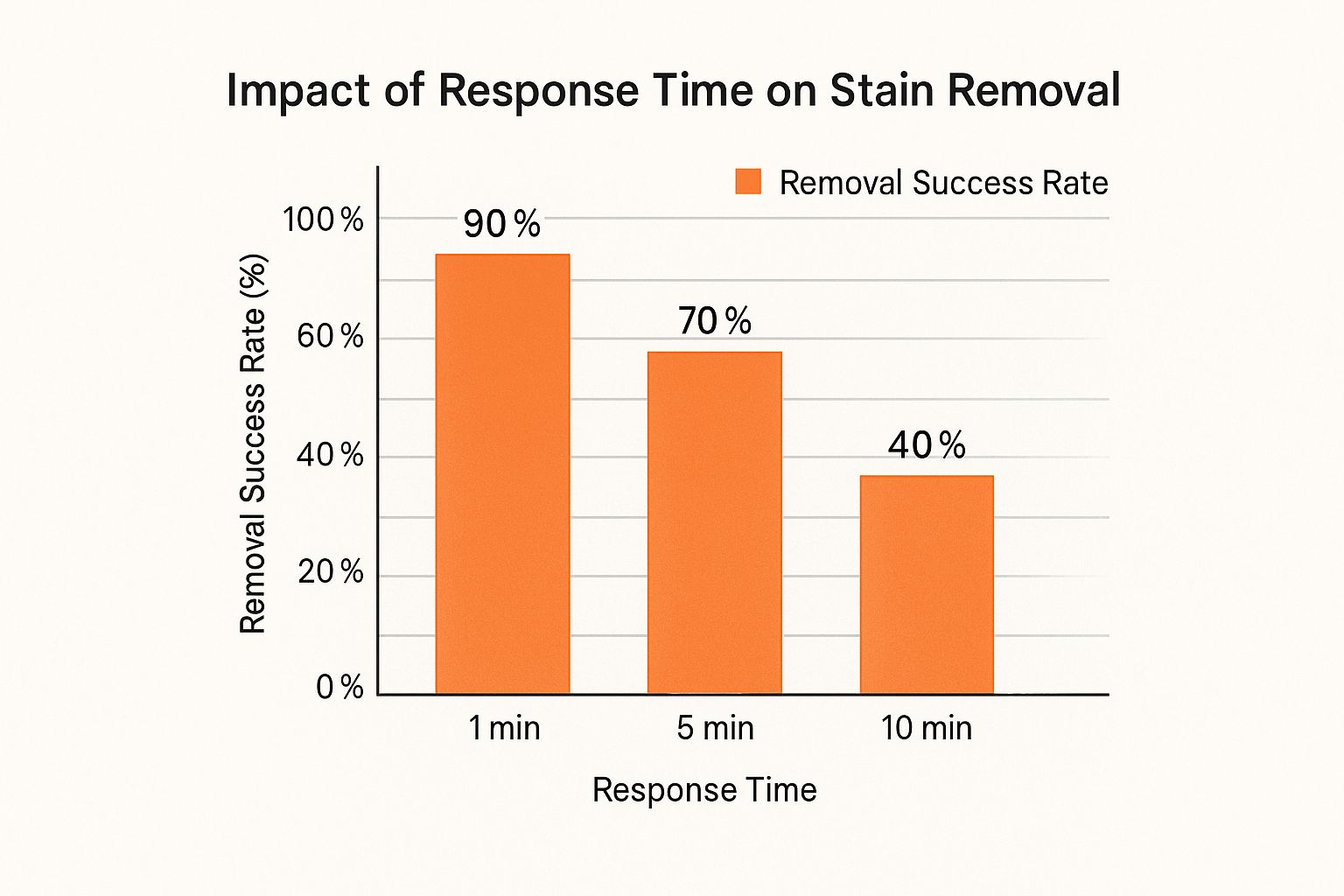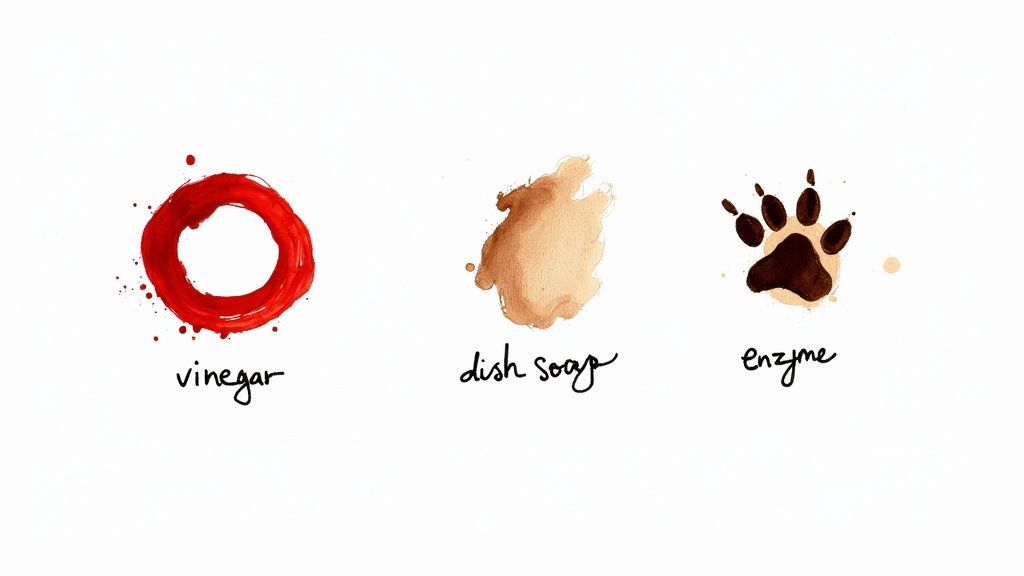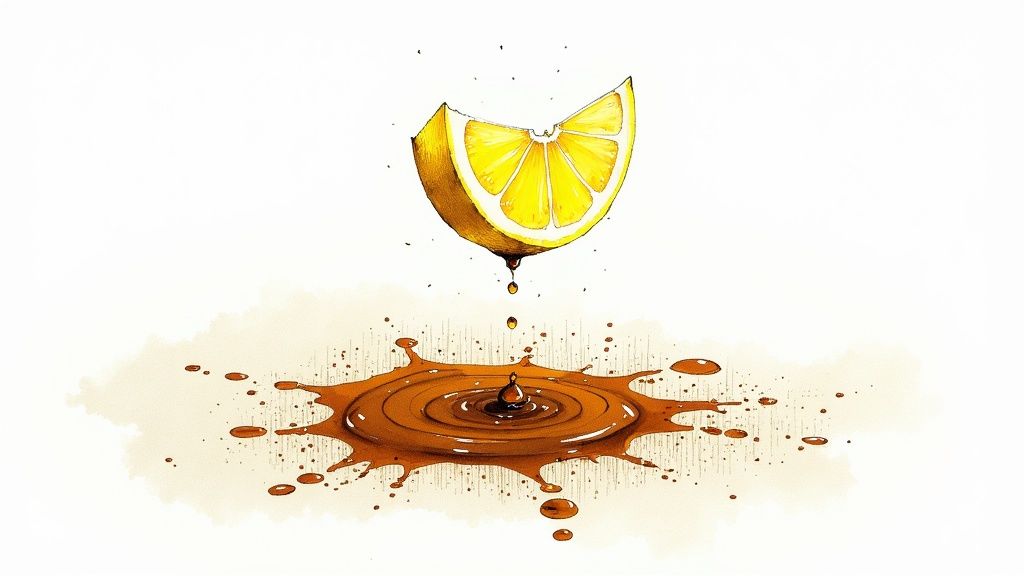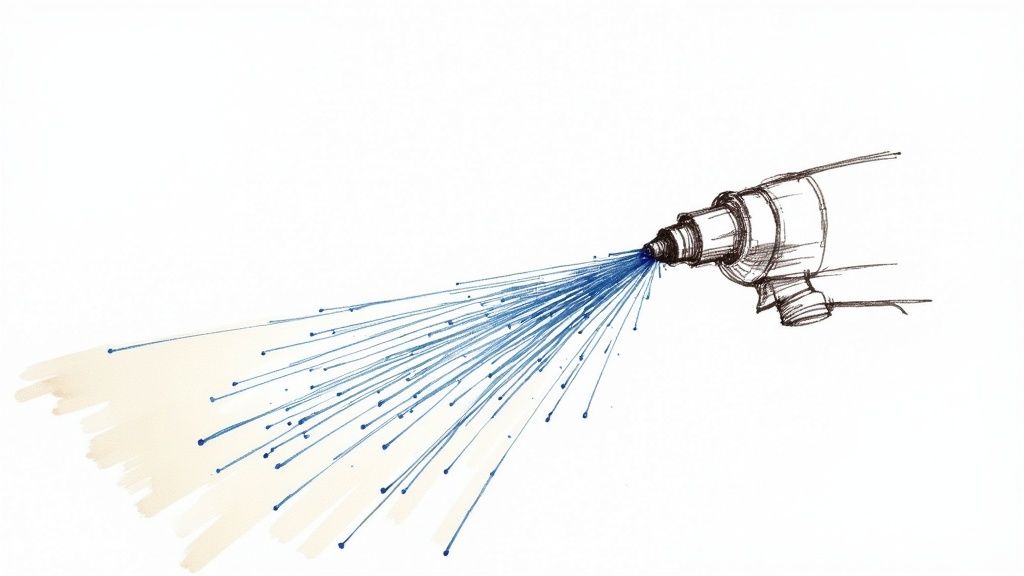When it comes to getting spots out of your carpet, how you react in the first few seconds makes all the difference. The single most important first move is to blot the spill with a clean white cloth. Whatever you do, never rub it. Your goal is to absorb as much of the liquid as you can before it has a chance to sink deep into the carpet fibers and the padding underneath.
Your First Move When a Carpet Spill Happens
We’ve all been there. That heart-stopping moment when a glass of red wine tips over or a full mug of coffee takes a nosedive onto the floor. Your gut instinct might be to grab the nearest sponge and start scrubbing like mad, but that's the worst thing you can do.
Scrubbing or rubbing a fresh spill literally grinds the liquid deeper into the carpet's fibers. Not only does this make the stain worse, but it can also damage the texture of the carpet permanently, leaving a fuzzy, worn-out patch.
Instead, you need a quick, calm response plan. The entire goal is to lift the spot out, not push it further in. Start by gently laying a clean, dry, white cloth over the fresh spill. Press down firmly and let the cloth act like a sponge. You’ll see the stain start to transfer onto the cloth. Keep turning the cloth to a fresh, clean section and repeat the blotting until you can’t pull up any more liquid. This simple action is your most powerful weapon in those first critical minutes.
The Power of Quick Action
For a lot of common liquid spills, a little club soda can be a fantastic follow-up trick. The carbonation actually helps lift the staining particles to the surface of the fibers, making them much easier to blot away. Just lightly dampen a new cloth with some club soda and continue your gentle blotting motion. Always work from the outside edge of the spot inward to keep it from spreading.
Remember, speed is your greatest ally. A spot that is addressed within a minute has a much higher chance of being completely removed than one left to sit for even ten minutes.
This chart really puts into perspective how crucial a quick response is for getting a stain out completely.

As you can see, waiting just a few extra minutes can tank your odds of a successful removal. While these first steps are great for everyday spills, some messes—especially pet accidents—require a much more specific game plan. For that, you’ll want to check out our guide on the best way to clean up after a pet accident.
Matching the Stain with the Right Solution

Successfully getting a spot out of the carpet is a bit like being a detective. First, you have to identify the culprit. The biggest mistake people make is treating an oily makeup smudge the same way they’d handle a coffee spill—and that can make the problem a whole lot worse.
Knowing what you're dealing with is everything. It's so important, in fact, that the global market for stain removers was valued at around USD 16.86 billion and is expected to keep growing. People are tired of generic cleaners that don't work. You can learn more about the stain remover market trends and see the full research from industry experts if you're curious.
Most common household stains fall into just a few categories, and each one has a specific weakness. Once you know what you’re up against, you can usually grab the right tool from your kitchen pantry to knock it out.
Figuring Out What Kind of Stain You Have
Before you start mixing up any solutions, just take a second to look at the spot. Is it a dark, watery stain like tea or red wine? Or is it greasy and thick, like where a piece of buttered toast landed face-down? Each one needs a totally different game plan.
Here’s a quick breakdown of the usual suspects you'll run into:
- Tannin Stains: These come from plants. Think coffee, tea, red wine, fruit juice—that sort of thing. They typically give up the fight when you introduce a mild acid.
- Oil-Based Stains: This is your grease, cooking oil, makeup, and even ink. Water won't do a thing to these. You need something that can break down and dissolve the oil itself, like a gentle soap or a solvent.
- Protein Stains: This group is all about organic stuff like mud, pet accidents, blood, or spilled milk. The number one rule here is NO HOT WATER. Heat will literally cook the protein into the carpet fibers, setting the stain for good.
Pro Tip: I can't stress this enough: Always test your cleaning solution on a hidden spot first. Dab a little inside a closet or under a sofa to make sure it doesn't bleach or damage your carpet. This one simple step can save you from a major headache.
Your DIY Stain-Fighting Toolkit
Once you've identified your enemy, you can mix up a simple, powerful cleaning solution with stuff you probably already own. This is the secret to getting spots out without immediately reaching for harsh chemicals.
For something like a coffee spill (a classic tannin stain), a simple mix of white vinegar and water often does the trick. If you're dealing with a greasy, oily spot, a few drops of gentle dish soap in a cup of warm water is perfect for breaking up that slick residue. And for muddy footprints? Let the mud dry completely, vacuum up all the loose bits, and then treat whatever's left behind.
Stuck on what to mix for which mess? This little guide should help you get started.
Quick Guide to DIY Carpet Spot Removers
Before you run to the store, check your pantry. You'd be surprised how many common carpet stains you can tackle with simple, everyday household items. Here’s a quick cheat sheet to match the mess with the right mix.
| Stain Type | Effective DIY Solution | How to Apply It |
|---|---|---|
| Coffee, Tea, or Red Wine | 1 part white vinegar, 1 part water | Mix in a spray bottle. Lightly spritz the stain and blot with a clean, white cloth. |
| Grease or Oil | A few drops of dish soap + 1 cup warm water | Dip a cloth in the soapy water, then gently dab the stain from the outside in. Rinse by blotting with a water-dampened cloth. |
| Pet Urine (Fresh) | 1 part white vinegar, 3 parts warm water | Blot up as much as you can first. Spray the vinegar solution, let it sit for 5-10 minutes, then blot dry. |
| Mud | Wait for it to dry completely | Scrape off and vacuum the dried mud first. Treat any remaining spot with a little dish soap and water. |
| Fruit Juice | 1 tablespoon lemon juice + 1 cup cool water | Blot the stain with the solution, then rinse by blotting with a cloth dampened with plain water. |
Remember, the key with any of these is to blot, never rub. Rubbing just pushes the stain deeper into the carpet fibers and can make it spread. Always work from the outside edge of the stain toward the center.
When DIY Just Won't Cut It, Go for Citrus Power

So, you’ve tried every trick in the book. You’ve scrubbed with vinegar, you’ve made a paste with baking soda, and that greasy, grimy spot is still staring back at you. We've all been there. It’s frustrating.
This is the point where most people throw in the towel and grab a heavy-duty chemical cleaner from the store. The problem? You might get rid of the spot, but you’re often left with harsh fumes and a sticky, chemical residue that actually attracts more dirt down the road. It’s a vicious cycle.
But hold on. Before you go that route, there’s a much smarter option. When your pantry solutions fall short, it’s time to call in the professionals and their secret weapon: citrus. This is truly the best way to get spots out of carpet that refuse to budge.
The magic comes from a powerful, all-natural solvent called d-Limonene. This isn't some synthetic chemical cooked up in a lab; it's extracted directly from the peels of citrus fruits like oranges and lemons. For those oily, sticky messes that laugh at water-based cleaners, d-Limonene is a complete game-changer.
Why Citrus Solvents Work When Nothing Else Does
Ever tried to wash greasy hands with just water? It’s impossible. You need soap to break down and lift the oil. D-Limonene works on that same principle, but it's supercharged for the tough, oil-based stains that plague carpets.
Think about stuff like:
- Grease splatters and cooking oil
- Sticky residue from tape or stickers
- Makeup, lipstick, and stubborn ink
- Melted gum or waxy spills
This natural solvent slices right through that grime, dissolving the bond it has with the carpet fibers so it can be whisked away for good.
The best part? Unlike those harsh chemical alternatives, quality citrus cleaners are often biodegradable and leave your home smelling fresh and clean, not like a chemical factory. They deliver a knockout punch to stains without punishing your family or your carpet. If you want to dive deeper into the science, we’ve got more info on why citrus-based cleaning is so effective and the benefits it brings.
Choosing a professional citrus-based cleaning is about more than just stain removal. It's about using a targeted, powerful solution that’s safe for your home and gentle on your carpet fibers, leaving them clean, soft, and completely residue-free.
When It's Time for the Big Guns: Hot Water Extraction

Let's be honest. Sometimes you've tried everything—the vinegar trick, the citrus cleaner, scrubbing until your arm aches—and that stubborn stain just won't budge. When you're fighting a losing battle against a deep, set-in spot or your entire carpet just looks exhausted, it’s time to call in the professionals' top weapon: hot water extraction.
You’ve probably heard this called "steam cleaning," and it's the ultimate reset button for your carpet. This isn't just a surface clean. The process shoots a high-pressure stream of hot water and a specialized cleaning solution deep down into the carpet fibers. Then, almost in the same breath, a beast of a vacuum sucks it all back out, pulling up every bit of dislodged dirt, grime, old residue, and allergens with it.
It’s so effective that the market for these machines is massive, valued at USD 1.10 billion and still growing. This isn't just hype; it's recognized as the best way to get spots out once they've taken hold in your carpet fibers. You can read up on the carpet extraction cleaner market to see just why this technology is trusted all over the world.
Renting a Machine vs. Hiring a Pro
So, you have a choice to make. Do you head to the local grocery store and rent a machine, or do you call a professional service? The right answer really comes down to what you're up against.
For a general refresh or some widespread but light soiling, a rental machine can be a decent, budget-friendly choice. It puts you in control, letting you clean on your own time, and it will definitely improve how your carpet looks.
But—and this is a big but—the equipment professionals use is in a completely different league. Their machines get the water hotter and have vacuums with far more suction power. This means they pull way more moisture and dirt out of the carpet. Not only does this give you a much deeper clean, but it also slashes the drying time, which is critical for preventing any mold or mildew from setting up shop.
A pro's experience with stubborn stains is priceless. They can actually identify what caused the spot and hit it with specialized pre-treatments that the all-in-one solutions with rental machines can't touch.
For the really tough jobs, calling an expert is usually the quickest and most effective way to go. Our guide to professional deep carpet cleaning services can give you a better idea of what to expect. While a DIY rental has its place, nothing beats the raw power and know-how that comes with commercial-grade gear when you need to bring a sad, soiled carpet back to life.
How to Prevent Carpet Spots in the First Place
Knowing how to get spots out of your carpet is a great skill to have, but let's be honest—preventing them from ever showing up is the real win. If you can shift your mindset from reactive to proactive, you'll save yourself a ton of headaches and keep your carpets looking fresh for years.
It all starts at the front door. Seriously. A good-quality doormat outside and an absorbent one inside will catch an unbelievable amount of dirt and moisture before it even gets a chance to touch your carpet. A simple "no shoes inside" rule is another absolute game-changer. You'd be amazed how much less dirt gets tracked through the house.
Build a Consistent Carpet Care Routine
Think of your vacuum as your carpet's best friend. Regular vacuuming isn't just for looks; it pulls up all those tiny, sharp particles of dirt and grit that literally grind down and shred your carpet fibers over time. That abrasive action is exactly what makes high-traffic areas look so dull and worn out.
- Hit high-traffic areas at least twice a week. This means hallways, entryways, and the main living spaces where everyone walks.
- Slow it down. Rushing with the vacuum doesn't do much. Making multiple, slow passes gives the brush and suction time to actually pull up the deep-down grit.
Getting your carpets professionally deep-cleaned every so often is the other piece of the puzzle. There's a reason the global carpet cleaner market is valued at USD 1.13 billion—people know that expert services are key for home hygiene. The pros use equipment that pulls out the deeply embedded soil your home vacuum just can't reach, which is critical for the long-term health of your carpet. You can discover more insights about the carpet cleaner market trends to see why so many homeowners are making this a priority.
The secret to a spotless carpet isn't just about cleaning up messes—it's about creating simple habits that stop them from ever taking hold.
Finally, after a good deep cleaning, think about applying a carpet protector spray. It creates an invisible shield that helps repel spills, giving you a few precious extra seconds to blot them up before they can soak in and become a permanent stain. These simple, consistent habits are your best defense against future spots.
Got Questions? We’ve Got Answers.
Even with the best advice, you're bound to have some lingering questions. Let's tackle a few of the most common dilemmas people run into when they’re trying to get a stubborn spot out of their carpet. Getting this right can save you from a costly mistake.
"Can't I Just Use a Little Bleach on a Tough Stain?"
Let me stop you right there. Absolutely not. This is probably the single most important thing to remember.
Using household chlorine bleach on your carpet will do one thing, and one thing only: permanently strip the color right out of the fibers. You'll be left with an irreversible white or yellowish patch that looks a hundred times worse than the original spot ever did. It can even eat away at the carpet's backing over time. Always, always stick to cleaners made specifically for carpets.
"How Fast Do I Really Need to Act on a Spill?"
You need to act immediately. When it comes to spills, time is your biggest enemy, bar none.
The longer a liquid sits, the deeper it soaks. It goes past the surface fibers and sinks right into the padding underneath. Once a stain hits the pad, it becomes incredibly difficult to get out completely. Your goal should always be to blot up as much of that spill as you can within the first few minutes, before it has a real chance to set.
A quick note on professional help: For routine cleaning, renting a machine can be a decent, cost-effective option. But for old, stubborn, or specialized stains like pet urine or red wine, a professional is your best bet. Their equipment is far more powerful and they have access to treatments that can save a carpet you might think is ruined.
So, should you call a pro every time? For a simple, fresh spill, probably not. But when you’re staring down a mystery stain or one that your DIY methods just won't touch, calling an expert saves you a ton of time, frustration, and could even save your carpet from being replaced altogether.
When you need a guaranteed clean without the harsh chemicals, the team at Citrus Carpet Cleaning Buford provides professional, citrus-based cleaning that leaves your carpets spotless and fresh. Get your free “EXACT-imate” today!

